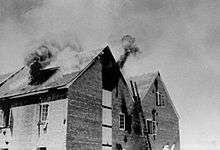German Village (Dugway proving ground)




German Village was the nickname for a range of mock residential houses constructed in 1943 by the U.S. Army in the Dugway Proving Ground in Utah, roughly a hundred kilometers southwest of Salt Lake City, in order to conduct experiments used for the bombing of Nazi Germany.
History
Dugway was a high-security testing facility for chemical and biological weapons. The purpose of the replicas of German homes, which were repeatedly rebuilt after being intentionally burned down, was to perfect tactics in the fire bombing of German residential areas during World War II.
The US Army employed German émigré architects such as Erich Mendelsohn to create copies as accurate as possible of the dwellings of densely populated poorer quarters of Berlin. The main goal was to find a tactic to achieve a fire storm in the city center. The working-class areas on which the test buildings were based, such as Wedding and Pankow, had been communist strongholds before Nazi repression suppressed dissent.
The architects who worked on the German village and on the Japanese equivalent also included Konrad Wachsmann and Antonin Raymond.
The US Army hired Standard Oil Development Company to assist in the practical testing and construction. Erich Mendelsohn and Konrad Wachsmann advised on construction techniques and materials.[1] Paul Zucker, Hans Knoll and George Hartmueller advised on designing authentic interior furnishings.[1]
The village was authentic down to the smallest details, including authentic German heavy furnishings, clothes hanging in closets and children's toys.[2]
Wood and paint, both for interior and exterior, was selected so it would be authentic both in the German and Japanese village; in the Japanese village there were chopsticks on the tables.[3] The German village cost $575,000 to build.[2]
It was found that it was easier to set fire to Japanese housing, but that German houses were more likely to have uncontrollable fires.[2]
See also
References
- 1 2 Robin Schuldenfrei, Atomic Dwelling: Anxiety, Domesticity, and Postwar Architecture, pages 117, 118
- 1 2 3 Lynn Eden, Whole World on Fire: Organizations, Knowledge, And Nuclear Weapons Devastation, pages 88–90
- ↑ Stewart Halsey Ros, Strategic Bombing by the United States in World War II: The Myths and the Facts, page 107
Further reading
- Mike Davis, "Berlin's Skeleton in Utah's Closet," in Dead Cities: And Other Tales (New York: The New Press, 2002; paperback 2003), 64-83; ISBN 978-1-56584-765-1 or ISBN 1-56584-844-6.
External links
![]() Media related to German Village (Dugway) at Wikimedia Commons
Media related to German Village (Dugway) at Wikimedia Commons
- Aerial view of German and Japanese villages, May 27 1943
- Assault on German village (Translation of article below)
- Angriff auf "German Village" Der Spiegel 11.10.1999
- German Village' may soon crumble
- Historic Evaluation of German Village at U.S. Army Dugway Proving Grounds
- US Army Bases
- Dugway MIL site on the village (With images of the village)
- Goodbye to Berlin
- Background and drawings from the US government
- themilitarystandard
Coordinates: 40°08′21″N 113°00′23″W / 40.139062°N 113.006425°W
